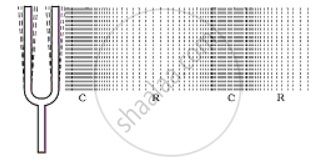Advertisements
Advertisements
प्रश्न
Distinguish between compression and rarefaction.
उत्तर
A longitudinal wave propagates by means of compressions and rarefactions.
When a vibrating object moves forward, it pushes and compresses the air in front of it creating a region of high pressure. This region is called a compression (C), as shown in Fig. This compression starts to move away from the vibrating object. When the vibrating object moves backwards, it creates a region of low pressure called rarefaction (R), as shown in Fig.

A vibrating object creating a series of compressions (C)
and rarefactions (R) in the medium
Compressions are the regions of high density where the particles of the medium come very close to each other and rarefactions are the regions of low density where the particles of the medium move away from each other.
APPEARS IN
संबंधित प्रश्न
The frequency of a source of sound is 100 Hz. How many times does it vibrate in a minute?
Fill in the blank.
The pitch of a sound depends on its ________.
How is sound produced ?
What are infrasonics? Can you hear them?
Name the type of waves produced when a tuning fork is struck in air.
Explain the terms 'compressions' and 'rarefactions' of a wave. What type of waves consist of compressions and rarefactions.
A sound wave of wavelength 1/3 m has a frequency 996 Hz. Keeping the medium same, if frequency changes to 1328 Hz. Calculate
- velcoity of sound
- new wavelength.
Which of the following vibrates when a musical note is produced by the cymbals in a orchestra?
In longitudinal waves, the particle vibrates in a ______ direction of propagation.
